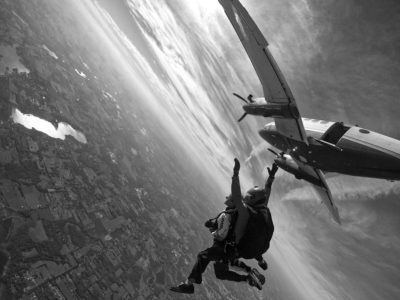- Michigan's Premier Skydiving Center
- Call Now: (517) 423-7720
Exploring The Thrilling History of Skydiving
Tuesday, July 30, 2024
- Skydive Tecumseh
- 7/30/24
- 0
- General
To us, skydiving is a well-known activity that dreamers strive to do and holds a place on many people’s bucket lists. But how did skydiving begin? And who was bold enough to turn dreams of human flight into a reality?
Skydiving – a sport that combines exhilarating freefall through the skies with the serenity of flying a parachute back down to the ground – has a rich and storied history. From its early beginnings to its modern-day advancements, the journey of skydiving is a testament to human ingenuity and the relentless pursuit of adventure and living life to the fullest. Let’s explore this rich history and further appreciate the sport of skydiving and how far it has come.
Who Invented Skydiving?
 When it comes to historical facts, it’s hard to determine the actual truth of things since, ya know, we weren’t exactly there to account for it. Just like everything else in history, the whos, hows, and whys of skydiving are all a little unclear – up in the air, if you will.
When it comes to historical facts, it’s hard to determine the actual truth of things since, ya know, we weren’t exactly there to account for it. Just like everything else in history, the whos, hows, and whys of skydiving are all a little unclear – up in the air, if you will.
So, who invented skydiving and why? Well, there are records of the Chinese sketching drawings of parachutes in the 1100s … 300 years later Leonardo da Vinci made some striking sketches … in 1797 a Frenchman named André-Jacques Garnerin made the first official skydive …. While we would love to credit just one person for the invention of skydiving, successful jumps require many people working together towards the same goal.
Skydiving History Timeline
The history of skydiving is complex. A parachute history timeline is the best way to view when skydiving came about, how it progressed, how it’s used for military operations, who invented tandem skydiving, and much more!
Early Concepts of Parachuting
1100s: The concept of descending from the skies with the aid of a parachute dates back centuries. The first recorded instance of a parachute-like device was created by the Chinese in the 10th century (wow!), who used rigid umbrella-like structures to perform stunts from towers as a form of entertainment!
1490: Leonardo da Vinci is credited as “the father of the parachute” for designing a pyramid-shaped parachute in the margin of a notebook. The sketch shows a gummed linen cloth with a length of 12 yards on each side and 12 yards high.
1617: It is rumored that Fausto Veranzio was allegedly the first man to build and test a parachute, implementing his design by jumping from St. Mark’s Campanile in Venice.
1783: Louis-Sébastian Lenormand jumped from the tower of the Montpellier observatory using a 14-foot parachute with a rigid wooden frame – much like the umbrella structures the Chinese used. He designed this parachute in hopes of helping occupants trapped in a burning building.
1797: André-Jacques Garnerin performs the first successful skydive from a great height (3,000 feet) in a gondola with a silk parachute in Paris, France. He went on to complete 200 more parachute jumps, one of them in England from 8,000 feet! A couple of years later, Garnerin’s wife, Jeanne Genevieve Garnerin became the first woman to make a parachute jump from 3,000 feet.
The Progressive Era
1885: Parachuting comes to the United States with Captain Thomas Scott Baldwin and his brother rediscovering the rigid parachute and redesigning it to be lighter and more flexible. They tested their parachute design with weighted sandbags from nearby cliffs. At San Francisco’s Golden Gate Park, Baldwin paid the park manager $1.00 per foot of height – with 2,000 feet being the maximum – to jump from a hot-air balloon! This was the first public descent from an aircraft with a parachute.
1907: Charles Broadwick invents static line jumping. He folded his parachute into a pack he wore on his back and the parachute was pulled from the pack by a static line attached to the hot air balloon. The static line would pull the parachute from the pack and snap. A year later, Albert Leo Stevens invented the ripcord that would manually open the parachute.
1911: Using silk parachutes, Grant Morton and Albert Berry would be the first people to jump from an airplane. Grant Morton jumped from a Wright Model B airplane in Venice Beach, CA, and Albert Berry made the second jump from an airplane near St. Louis, MO.
1914: Georgia “Tiny” Broadwick, becomes the first person to jump freefall by deploying her parachute manually while in freefall as opposed to using a static line. She demonstrated this jump for the U.S. Army. This would kickstart the use of skydiving for military operations as a way to save aircrews from emergencies aboard aircraft in flight.
Military Origins & Sport Parachuting
1930: The first competitive parachute meet takes place in Russia at the International Sports Festival. Contestants would receive points for accurately landing on a ground target. It’s safe to say that this moment marks the day that skydiving became a sport. This year would also mark the start of wingsuit jumping with the first successful wingsuit jump taking place in California, USA. The wingsuits were made of materials like canvas, wood, silk, steel, and even whale bone.
1944: The United States heroically takes to the skies during World War II.
The Transition to Recreational Skydiving
1946: Joe Crane established the National Parachute Jumpers-Riggers, Inc. which would eventually become the United States Parachute Association (USPA), which is still active today. Skydive Tecumseh is a proud member of the USPA!
1955: The modified C-9 Flat Circular Parachute becomes the most commonly used sport parachute and the first steerable parachute.
1959: The first commercial dropzone is established in Orange, MA, USA, by Lew Sanborn and Jacques-André Istel. They developed a civilian training center for anyone to learn how to skydive.
1962: The first ram-air parachute is invented by Domina Jalbert and Paul J. Poppenhager. These parachutes offered greater steerability and speed than the typical round parachutes.
Modern Day Skydiving
1970s: Jumpers start skydiving together, birthing formation skydiving. Building bigger and bigger rounds.
1982: Bill Booth designs the 3-ring system (three metal rings looped through one another), to serve as the attachment point between the parachute and the container. This was a huge advancement for the sport, as it made cutting away parachute malfunctions a breeze.
1983: Tandem skydiving is invented by Ted Strong, to provide skydiving to everyday people without having to commit to learning to skydive by themselves.
1989: The Automatic Activation Device (AAD) is invented. This is a tiny computer that will automatically initiate the reserve deployment sequence if the jumper fails to pull their main parachute at a certain altitude and speed. AADs have saved many lives!
From there, skydiving has grown exponentially with the introduction of BASE jumping, modern wingsuits, free-flying, large formations, competitions, canopy piloting, high-altitude jumps, world records, and many other accomplishments!
We invite you to be a part of the continuing story of skydiving – book your skydive today with Skydive Tecumseh! Blue skies.

I drove more than 2 hours to jump with Tecumseh because I wanted a reputable company and I was not disappointed. They were very safety minded and professional. The staff was very friendly and made the whole experience fun! If you're only doing it once, pay the extra and get the video package. Very well done, you won't be disappointed.
Ken Reeves
Copyright © 2025, Skydive Tecumseh, All Rights Reserved.
DropZone Web Design & Marketing by Beyond Marketing, LLC